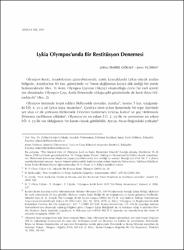| dc.description.abstract | The church studied in the present article is located in the west part of the ancient city of Olympos, to the south of the northern necropolis's entrance and on the north side of the river bed. The building was surveyed and cleaned in 2007, revealing a building that was actually a basilical church based on the stylobate formation. There were in situ column bases. The church, built on the north side of the river bed, has survived only with the north side aisle and the north annex in tact. The nave and the south side aisle must have been demolished by a flood or landslide. First of all, a restitution plan of the building was prepared based on available data. The commonly seen 1:2 proportion of the side aisle over the nave during the Early Byzantine period church architecture is taken as a criterion. Thus, the side aisles would have been equal to each other while the nave would have been equal to the total of the side aisles' width. According to the restitution proposal the church is a three-aisled Hellenistic basilica whose aisles are separated from each other by five columns on a stylobate. The apse on the central axis would be semi-circular both inside and out, as was common in Lycia. The doorway on the west side of the north aisle shows that the naos was accessed via a doorway on the axis of each aisle. Another doorway on the east side of the north aisle opens to a room to the north of the apse. The extension of a wall fragment on the northeast of the church indicates that it had no connection with the apse, if this wall turned south, encircling the apse, there would be a need for an annexed room to the east of the south side aisle as well. Thus, the rooms formed on either side of the apse would be connected to each other via a corridor to the east of the apse. Since the river flows along the south side of the building, no entranceway on the south side is proposed. Restitution based on side-aisle: For the nave, various ratios and proportions were tried. In the first model, the building is filled with squares of 2.5 m. which equals the width of the north aisle. In the second model, the naos is first divided into three equal parts in the east-west direction. Then it was divided into two equal sections by a line passing through the center of the apse-arc. In other models, the circle and arc fragments were usied together. The first of this method, (i.e. the third model) involved drawing arcs that pass through the centers of the columns, starting from the west end of the south stylobate. The fourth model involved a similar application of the third model, but was based on ares passing through the centers of the columns on the north stylobate. The fifth model involved division of the naos into three equal parts while the sixth one involved circles. The last two models were devised for identifying the basic unit employed for the design of the building and its use. This shows that even at a remote small center like Olympos, Byzantine church architecture followed certain mathematical and geometric rules in late antiquity. In summary, a reconstruction of the original church building using only the surviving north aisle was attempted by employing the extant architectural data. Known mathematical and geometric rules of the Byzantine church architecture were employed and a reliable restitution on the plan base was sought. | en_US |


















